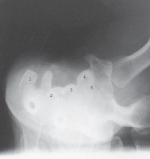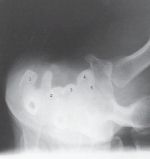A) Radial deviation
B) Ulnar deviation
C) Carpal canal
D) Carpal bridge
F) B) and D)
Correct Answer

verified
Correct Answer
verified
Multiple Choice
Where is the CR centered for a PA projection of the hand?
A) At the third proximal interphalangeal joint
B) At the third metacarpophalangeal joint
C) At the base of the third metacarpal
D) At the third distal interphalangeal joint
F) A) and B)
Correct Answer

verified
Correct Answer
verified
True/False
Carpal tunnel syndrome is more common in middle-aged women than in middle-aged men.
B) False
Correct Answer

verified
Correct Answer
verified
Multiple Choice
This projection is correctly referred to as: 
A) carpal canal, inferosuperior projection.
B) carpal tunnel, inferosuperior projection.
C) Gaynor-Hart method.
D) all of the above.
F) A) and C)
Correct Answer

verified
Correct Answer
verified
Multiple Choice
Select the correct manual exposure adjustment for each disease or condition. -Bursitis
A) Increase (+)
B) Decrease (-)
C) No change (0)
E) B) and C)
Correct Answer

verified
Correct Answer
verified
Multiple Choice
Which wrist ligament is attached to the styloid process of the ulna and continues to the triquetrum and pisiform?
A) Radial collateral ligament
B) Dorsal radiocarpal ligament
C) Palmar radiocarpal ligament
D) Ulnar collateral ligament
F) B) and C)
Correct Answer

verified
Correct Answer
verified
Multiple Choice
A radiograph of a tangential, inferosuperior projection of the carpal canal reveals that the hamular process is superimposed over the pisiform.Which of the following measures will correct this problem?
A) Rotate the wrist and hand 10° internally.
B) Increase the CR angle.
C) Decrease the CR angle.
D) Increase the extension of the hand and/or wrist.
F) All of the above
Correct Answer

verified
Correct Answer
verified
Multiple Choice
Which routine projection of the elbow will best demonstrate an elevated or visible posterior fat pad?
A) True AP with no rotation
B) True lateral with 90° flexion
C) Lateral rotation oblique
D) Coyle method
F) B) and C)
Correct Answer

verified
Correct Answer
verified
Multiple Choice
A radiograph of an AP oblique elbow with medial rotation reveals that the radial head is superimposed over part of the coronoid process.What positioning error has been committed?
A) Excessive medial rotation
B) Flexion of the elbow
C) Excessive lateral rotation
D) Incorrect CR angulation
F) None of the above
Correct Answer

verified
Correct Answer
verified
Multiple Choice
Grids are generally not required unless the anatomy measures greater than _____ cm in thickness.
A) 8
B) 10
C) 14
D) 5
F) None of the above
Correct Answer

verified
Correct Answer
verified
Multiple Choice
The joint found between the base of the third metacarpal and carpal bone is the:
A) intercarpal.
B) interphalangeal.
C) carpometacarpal.
D) proximal metacarpophalangeal.
F) None of the above
Correct Answer

verified
Correct Answer
verified
Multiple Choice
A ginglymus joint can also be referred to as a _____ joint.
A) trochoid
B) saddle
C) hinge
D) pivot
F) None of the above
Correct Answer

verified
Correct Answer
verified
Multiple Choice
Which carpal bone is 1? 
A) Scaphoid
B) Trapezium
C) Hamate
D) Pisiform
F) None of the above
Correct Answer

verified
Correct Answer
verified
Multiple Choice
A radiograph of a PA projection of the hand reveals that the distal radius and ulna and the carpals were cut off.What should the technologist do to correct this problem?
A) Accept the radiograph.Carpals and distal radius and ulna are not part of a hand study.
B) Make sure the carpals, distal radius, and ulna are included on the lateral projection.
C) If the injury to the patient did not involve the carpal region and distal forearm, do not repeat it.
D) Repeat the PA projection to include all the carpals and about 1 inch (2.5 cm) of the distal radius and ulna.
F) B) and D)
Correct Answer

verified
Correct Answer
verified
Multiple Choice
Which two structures primarily form the hinge-like structure and movement of the elbow joint?
A) Trochlea and olecranon process
B) Capitulum and trochlea
C) Coronoid process and coronoid fossa
D) Coronoid fossa and trochlea
F) All of the above
Correct Answer

verified
Correct Answer
verified
Multiple Choice
Which specific anatomy is better visualized with a fan lateral as compared with the other lateral projections of the hand?
A) Sesamoid bones
B) Carpals
C) Phalanges
D) Carpometacarpal joints
F) None of the above
Correct Answer

verified
Correct Answer
verified
Multiple Choice
Why is it important to keep the phalanges parallel to the IR for a PA oblique projection of the hand?
A) Prevents foreshortening of phalanges and obscuring of interphalangeal joints.
B) Prevents foreshortening of radiocarpal joint.
C) Opens up the carpometacarpal joints.
D) Demonstrates the sesamoid bones near the first interphalangeal joint.
F) None of the above
Correct Answer

verified
Correct Answer
verified
Multiple Choice
Why is it recommended that the PA oblique (with medial rotation) projection be performed rather than the PA oblique (with lateral rotation) for the second digit of the hand?
A) Minimizes optimal immunomodulating dose (OID) .
B) Is more comfortable for the patient.
C) Opens up joints better.
D) Minimizes object image-receptor distance (OID) .
F) A) and B)
Correct Answer

verified
Correct Answer
verified
Multiple Choice
Which routine projection of the elbow best demonstrates the radial head and tuberosity free of superimposition?
A) AP
B) Lateral
C) AP oblique with internal rotation
D) AP oblique with external rotation
F) A) and B)
Correct Answer

verified
Correct Answer
verified
Multiple Choice
Match each fracture description with the corresponding term.(Use each choice only once.) -Fracture of distal radius with posterior displacement
A) Smith fracture
B) Barton fracture
C) Colles' fracture
D) Bennett's fracture
E) Boxer's fracture
G) B) and C)
Correct Answer

verified
Correct Answer
verified
Showing 21 - 40 of 107
Related Exams